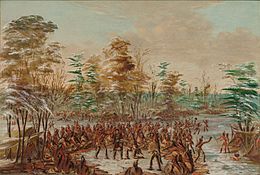Henri de Tonti facts for kids
Quick facts for kids
Henri de Tonti
|
|
|---|---|

|
|
| Co-founder of Fort St. Louis, Illinois country | |
| In office Founded 1682 |
|
| Monarch | Louis XIV of France |
| Personal details | |
| Born |
Enrico Tonti
c. 1649 Gaeta |
| Died | September 1704 (aged c. 55) Fort Louis, Louisiana (present-day Mobile County, Alabama) |
| Cause of death | Yellow fever |
| Relations |
|
| Signature |  |
| Nicknames |
|
| Military service | |
| Allegiance | |
| Years of service | c. 1668–1676 |
| Rank | Captain |
| Battles | Franco-Dutch War |
Henri de Tonti (born Enrico Tonti; around 1649 – September 1704) was an Italian-born French military officer and explorer. He helped René-Robert Cavelier, Sieur de La Salle explore and settle North America from 1678 to 1686.
De Tonti was one of the first explorers to sail the upper Great Lakes. He also traveled the Illinois and Mississippi rivers. They sailed the Mississippi all the way to its mouth. There, they claimed the land for King Louis XIV of France. De Tonti later started the first lasting European settlement in the lower Mississippi valley. This place was called Poste de Arkansea. Because of this, he is known as "The Father of Arkansas."
Contents
Early Life and Military Service
Henri de Tonti was born in Gaeta, Italy, around 1649. His parents were Lorenzo and Isabelle de Tonti. His father, Lorenzo, was a banker and governor of Gaeta. He is known for inventing the tontine, a type of life insurance.
Henri's family had to move to France around the time he was born. This was because his father was involved in a revolt against the Spanish ruler in Naples. Henri's brother, Alphonse, was born in 1659. Alphonse later helped found the city we now know as Detroit. Henri's cousins, Daniel Greysolon Dulhut and Claude Greysolon de La Tourette, also became famous in New France.
Joining the French Army
In 1668, when he was about 18, de Tonti joined the French military. For his first two years, he was a cadet in the French Army. After that, he spent four years as a midshipman. He went on seven sea trips, some on warships and some on galleys.
De Tonti later became a captain-lieutenant in Messina, Sicily. He was part of a troop sent by King Louis XIV in 1675. They went to support a rebellion in Messina during the Franco-Dutch War.
The "Iron Hand"
During military actions near Messina, de Tonti was injured. He lost his hand in a grenade explosion. He was also taken as a prisoner of war. After six months, he was set free in exchange for the governor's son.
When he returned to France, de Tonti kept serving in the military. From then on, he wore a metal hook covered by a glove where his hand used to be. This earned him the nickname "Iron Hand." After the war, de Tonti found it hard to get work. But then, La Salle hired him for his explorations.
Exploring New France

In the summer of 1678, de Tonti traveled to Quebec with René-Robert Cavelier, Sieur de La Salle. La Salle saw that de Tonti was a skilled helper and made him his lieutenant. They arrived in Gulf St. Lawrence on August 27. De Tonti described it as "A place extremely cold where no wheat grows."
On December 26 of the same year, de Tonti and La Salle reached the Niagara. De Tonti stayed to oversee the building of Fort Conti below Niagara Falls. He also supervised the building of the Griffon above the falls in early 1679. The Griffon was the first ship to sail the Great Lakes.
Building Forts and Facing Challenges
In August 1679, de Tonti arrived at Fort Michilimackinac. This was an important place for fur trading. He found that some of La Salle's crew had run away and traded many goods. After gathering the deserters, de Tonti sailed to the mouth of the St. Joseph River. He helped set up Fort Miami there.
In early 1680, de Tonti also helped build Fort de Crèvecoeur in Illinois. La Salle left de Tonti in charge of this fort while he went back to Ontario. On his way back up the Illinois River, La Salle thought that Starved Rock would be a good spot for another fort. He sent a message to de Tonti about this idea.
Following La Salle's orders, de Tonti took five men and went up the river. They were to check if Starved Rock was suitable for a fort. Soon after de Tonti left, on April 16, 1680, the seven men left at Fort de Crèvecoeur robbed and left the fort. They started their own journey back to Canada. This allowed Iroquois warriors to attack. De Tonti was injured, and his men had to retreat to Baie-des-Puants in late 1680. In 1681, after recovering, de Tonti went to Fort Michilimackinac to meet La Salle again.
Co-founder of Fort St. Louis, Illinois

In the spring of 1682, de Tonti traveled with La Salle down the Mississippi River. He helped make friends with Native American tribes. He presented the calumet (a peace pipe) to the Natchez tribe. This allowed La Salle to travel inland and meet their chief.
Thinking they had made peace, de Tonti tried to convince the Natchez to move closer to their new fort, Fort St. Louis. This would help them trade with each other. La Salle left for France in 1683 to find more settlers for a new Louisiana project. He left de Tonti to hold Fort St. Louis.
Changes in Command
While La Salle was away, Joseph-Antoine Le Febvre de La Barre, the governor of New France, took over all of La Salle's new lands. Even though de Tonti helped fight off Iroquois attackers, he was no longer in charge of the Illinois territory. Louis-Henri de Baugy replaced him. De Tonti went back to Quebec in the spring of 1684.
Later, La Barre changed his mind and gave La Salle's territories back. De Tonti returned in 1685.
Establishing Arkansas Post
De Tonti heard that La Salle was in the Gulf of Mexico. So, de Tonti went south in 1686 to try and meet him. He didn't meet La Salle, but he set up a trading post in Arkansas. He left six Frenchmen there to create a lasting French settlement. This post would help trade with the Quapaw tribe. It would also help stop English invasion from the east by having a French presence in the middle of North America.
In 1689, de Tonti learned that La Salle had been killed by his own men. De Tonti then started a journey to La Salle's abandoned settlement in Baie Saint-Louis. But he was not prepared enough and turned back. He returned to Illinois. In late winter 1690, resources became scarce. He moved Fort St. Louis to Pimiteoui (present-day Peoria). This new Fort St. Louis (also called Fort Pimiteoui) became the main French trading post.
Military Campaigns and Treaties
In the summer of 1685, Jacques-René de Brisay de Denonville became the new governor of New France. Denonville believed war with the Iroquois was unavoidable. He promised Illinois "every protection" and asked de Tonti for advice on military plans. Denonville gave de Tonti a key role in this military campaign.
De Tonti was supposed to attack the Iroquois from behind with 300 men. Denonville would launch a full attack from the front. De Tonti couldn't gather enough men for his part. So, he joined Sieurs de l'hut and de la Durantais at the front. De Tonti and the others went to their meeting point on Lake Ontario. They met Denonville and took part in the main French attack against the Senecas.
They later set up a military post in Niagara. In 1687, de Tonti was involved in wars with the English and their Iroquois allies. During this time, he also made treaties with Native American tribes. In 1690, after he was given La Salle's fur trading rights, de Tonti helped French settlement in Illinois by trading. In the summer of 1687, he left Illinois in the care of his cousin Pierre de Liette.
De Tonti then began a journey down the Mississippi. He wanted to contact Pierre Le Moyne d'Iberville, who had started the Louisiana colony. De Tonti reached Louisiana and joined the colony.
Later Life and Death
After joining the Louisiana colony, Pierre Moyne, Sieur d’Iberville, offered de Tonti a job. He was to be a treaty negotiator and peacemaker. Working under Pierre Moyne's brother, Jean Baptiste Le Moyne de Bienville, de Tonti helped bring peace. He made peace between the Choctaw and Chickasaw nations of Louisiana. He then received help from both nations.
The Native American tribes believed de Tonti had special powers because of his metal hand. Henri de Tonti died in September 1704 from yellow fever. It is thought that his remains were buried in an unknown grave near the Mobile. This spot is not far from the monument built in 1902 to remember the site of old Mobile.
See also
 In Spanish: Henri de Tonti para niños
In Spanish: Henri de Tonti para niños


